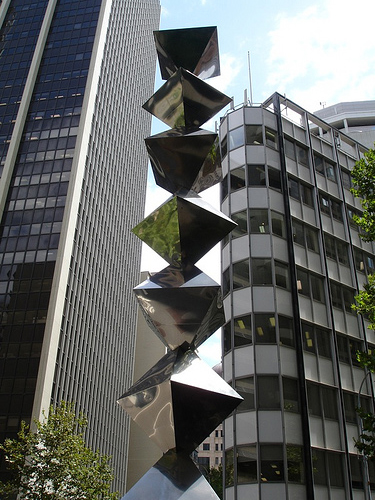Ian Shadwell gazes upon one of Sydney’s most iconic – but equally maligned – pieces of public art and finds within its shiny surfaces something to love…
This week, we’re going to stay in Martin Place – kind of. After you’ve alighted from the train and taken the time to have a look at Sydney I and Sydney II, walk further down Martin Place toward George street and have a look at the plinth above the fountain on Pitt street, the place where they stage all the big corporate events. Now close your eyes and imagine a sculpture, 19 metres high, a shining stainless steel testament to the beauty of the human spirit. It would be marvellous to have something like that there, no? Well, there used to be.
Bert Flugelman‘s Pyramid Tower (Dobell Memorial Sculpture) [1978] was a site specific stainless steel sculpture created for an artistic prize commissioned by the Dobell foundation to find a permanent work for Martin Place.
When Flugelman won, he was already well established in Australia’s contemporary art scene, with major commissions in most of the capital cities, as well as a teaching post at the South Australian school of art. His ouvre, was rigorously geometrical, concerning itself with “Platonic idealities.” Cones, spheres and pyramids arranged in coherent lines. His work, was elegant, spare and monumental. His winning entry for the Martin Place competition being typical of this period, a massive column of regular triangular shapes fashioned from highly polished stainless steel.
From the moment of its installation it became known as the steel “shish-kebab” for obvious reasons. At nineteen and a half metres high it had an heroic scale that seemed to intimidate Sydneysiders. It was more or less condemned universally, the chorus of naysayers being led by that well known aesthete Frank Sartor. But not everyone hated it. Skateboarders thought it was awesome, allowing them to execute massive grinds on its stainless steel sides. And of course I loved it. I loved its shiny space age purity, its “unalloyed” Modernism bringing a sophisticated edge to an urban space that was crying out for some nice jewelry. Yet, “the people” did not like those hard mirrored surfaces reflecting their bustling lives back at them. Rather than seeing a monument to the human spirit, reaching out of the urban trough into the bright blue sky of hope, they saw a “steel shish kebab” reminding them of drunken Saturday nights after the pub. Or a pile of geometric solids from their maths class. But they did not see art. And so, under the leadership of the afore mentioned Mr Sartor, in the quiet before the storm that was the Sydney Olympics, it was “disappeared,” conveniently freeing the space for sponsored “community events” celebrating the vigorous spectacle that is the Olympics. And so a triumphant moment in Australia’s long and colorful history of art hate was celebrated by drug enhanced bodies dancing the night away in celebration of drug enhanced bodies running very fast somewhere in Homebush, whilst the silver shish kebab lay unhappily on its blanket of canvas awaiting a new home. But who would have her?
Images: Asiatic League, via Flickr under Creative Commons License.
Sydney’s suits, bless them. One morning we found her quietly liberated, standing tall and proud on a traffic island on Spring street just down from the Sydney Stock Exchange.
But, let me tell you a secret, I actually think it works better in its new home. The little traffic island, crowded by buildings, adds a certain piquancy to its vertical thrust. The aspirational aspect of its, upward movement being more particular, more visceral, surrounded so closely by the city traffic and buildings. True, we no longer see the blue sky, reflected from her upper flanges, but she seems more coherent, more severely beautiful dealing with the patterned chaos of the urban fenestrations that push at her so closely from every side.
In any case, it is certainly worth dawdling down two blocks from Martin Place, to have a look at her. When you get up close, see if you can still find the marks of the skateboarders K-grinds on her lower slopes.



I have never inspected this piece close enough to observe the skateboard erosion but have always enjoyed it. I moved to Sydney in 2000 an when I first came across this piece I felt like I was in a proper city with substantial sculpture. I look forward to a report on the treasures of Australia Square. Keep up the good work.
Pingback: Tweets that mention Art Life walking tour part 2 | -- Topsy.com
Yes, this reminds me of Melbourne’s Yellow Peril controversy. I had a business career then and remember being picked up at Tullamarine by our Victorian Manager who made a special detour on the way to our office to point out me “this horrible yellow thing” which had been removed from its site and placed in what looked to me like a rubbish dump. I remarked that it looked terrific to my eye and he couldn’t believe it. He said only a Sydney sculptor make such expensive crap. I also remember the press and political condemnation of our Sydney Opera House design. Now both Ron Robertson Swan and Joern Utzon are revered. Times change.
Along with some other sculptors I spent a day with charming old Bert Flugelman at his Southern Highlands studio last year and he was philosophical about the Pyramid Tower and, undaunted, he is still doing beautiful work.
I love the pyramid tower sculpture. This is what our cities need more of rather than less of – something to evoke the human spirit, something to give it a sense of space… as much as a sense place, to define it from every other urban space in the world. Please send your unwanted art to Brisbane, but please check with the ‘elders’ first!